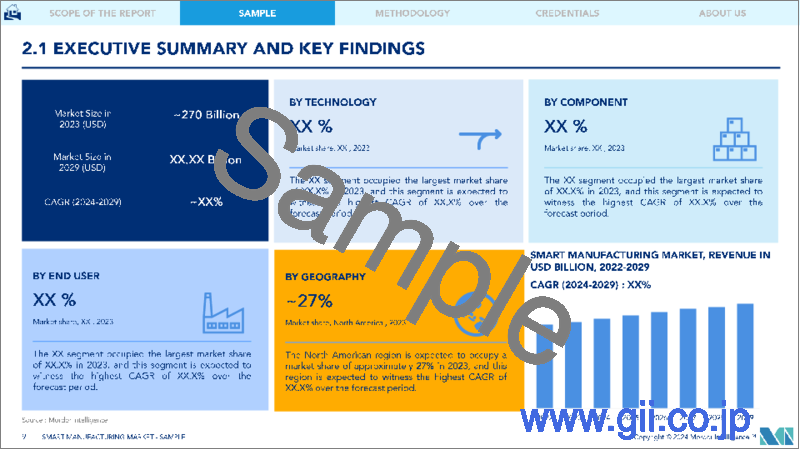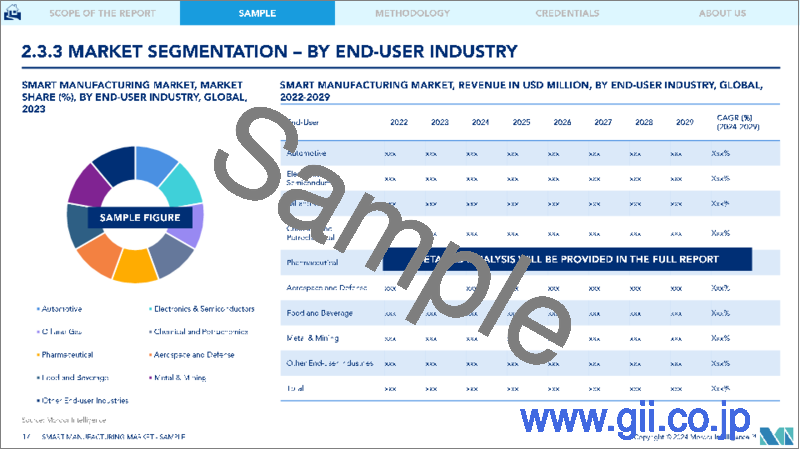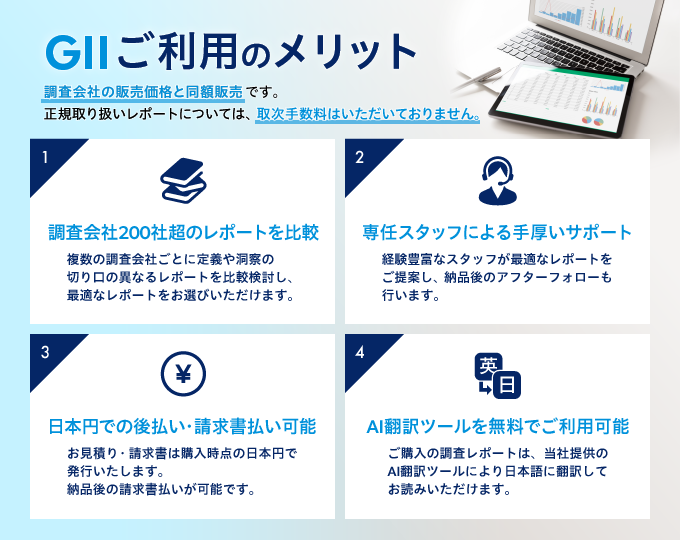|
|
市場調査レポート
商品コード
1639543
スマートマニュファクチャリング:市場シェア分析、産業動向・統計、成長予測(2025年~2030年)Smart Manufacturing - Market Share Analysis, Industry Trends & Statistics, Growth Forecasts (2025 - 2030) |
||||||
カスタマイズ可能
適宜更新あり
|
|||||||
| スマートマニュファクチャリング:市場シェア分析、産業動向・統計、成長予測(2025年~2030年) |
|
出版日: 2025年01月05日
発行: Mordor Intelligence
ページ情報: 英文 100 Pages
納期: 2~3営業日
|
全表示
- 概要
- 目次
スマートマニュファクチャリング市場規模は、2025年に1,620億米ドルと推定され、予測期間中(2025-2030年)のCAGRは14.58%で、2030年には3,199億4,000万米ドルに達すると予測されます。

スマートマニュファクチャリング導入に向けた取り組みの増加が、市場成長の原動力となると思われます。SMLC(Smart Manufacturing Leadership Coalition)は、米国を拠点とする産業団体、テクノロジー・サプライヤー、研究所、大学の連合体であり、次世代スマートマニュファクチャリング・プラットフォームとスマート・ファクトリー・コネクティビティに取り組んでいます。同様に、産業界主導のもうひとつのイニシアチブであるインダストリアル・インターネット・コンソーシアム(IIC)は、産業オートメーションの成長を加速するために必要な先進技術と組織を結集するために結成されました。
SCADA、ERP、HMI、PLC、DCS、PLM、MESなどのサービスやソフトウェアを使用することで、産業界はリアルタイムのデータを収集し、意思決定を行うことができるようになった。このソフトウェアは、製品エラーを減らし、ダウンタイムを減らし、計画的なメンテナンスを実施し、反応段階から予測・処方段階へと移行し、意思決定を可能にするため、産業界にとって有益です。
ITとオペレーティング・テクノロジー・システムの融合と組み合わされたプロセス制御とシステムへの依存は、製造業をサイバー攻撃にますますさらしています。製造業者の制御システムは、独自にカスタマイズされたネットワークのため、長い間侵入不可能と見なされてきました。IoTは、専有情報が盗まれる可能性を広げています。もともと適切なセキュリティ対策なしに構築されたこれらの機器の自動化とデジタル化が進むにつれ、データ・セキュリティの懸念も高まり、市場成長の妨げとなります。
さらに、インダストリー4.0への投資は世界的に増加しています。組織は、生産性の向上などビジネスへのプラスの影響から、インダストリー4.0のスマート・ソリューションの採用を開始しています。例えば、CapgeminiとNational Association of Software and Services Companies(NASSCOM)のレポートによると、2025年までにインドの製造業の3分の2以上がインダストリー4.0を採用すると予想されています。
さらに、市場競争を勝ち抜くために、各企業はイノベーションに注力し、新製品を投入しています。例えば、2023年2月には、産業用IoT、スマート工場、運用技術(OT)に関する未解決の主要課題に対処するため、プログラマブル・ロジック・コントローラーOTACの発売を発表しました。これは、典型的なICS/OTのセキュリティ課題を解決するために、同社の動的な「ワンタイム認証コード」(OTAC)技術を活用することで、PLCデバイスに特化した高度に最適化された安全性の高い認証ソリューションを提供します。
COVID-19の発生は、製造業が従来の生産プロセスを再評価するきっかけとなり、主に生産ライン全体でデジタルトランスフォーメーションとスマートマニュファクチャリングを推進することになった。製造業者はまた、製品と品質管理を監視するために、複数の俊敏で新しいアプローチを実装し、考案することを余儀なくされました。
スマートマニュファクチャリング市場の動向
自動車産業が市場成長を牽引する見込み
自動車製造は、スマートテクノロジー、インダストリー4.0、IoTなどから強い推進力を得ることが期待されます。ディスクリート製造とは、個々に数えたり触れたりできる個別の部品を生産または製造することです。この部品は主に組立ラインに関連しています。ディスクリート・マニュファクチャリングには、自動車や自動車部品など、ますます接続されるようになった製品も含まれます。
スマートマニュファクチャリングは、需要と供給のバランスを取り、製品設計を強化し、製造効率を最適化し、無駄を大幅に削減するのに役立つと期待されています。ロボットやセンサーなどのフィールド機器やICSは、自動車部門に市場の要求に迅速に対応し、製造のダウンタイムを減らし、サプライチェーンの効率を高め、生産性を拡大する機会を提供します。
スマートマニュファクチャリングは、自動車業界の最大の関心事であるプロジェクト期間に対応します。低コストの自動化やコスト革新と組み合わされた投資回収の早いプロジェクトは、生産性向上によるメーカーの競争力向上に役立っています。
さらにUBSによると、欧州の電気自動車販売台数は2025年までに633万台に達すると予測され、次いで中国が484万台となります。欧州とアジア太平洋が電気自動車の需要をリードしていることから、この地域ではスマート自動車工場の導入が増加すると予想されています。
自動車製造の情勢の変化に対応するため、業界の多くの企業がスマートマニュファクチャリングソリューションを導入しています。例えば、2022年1月、HASCOとしてビジネスを展開するHuayu Automotive Systems Co.とABBグループは、「次世代のスマートマニュファクチャリングを推進する」ために、既存の関係を基に合弁会社を設立したと発表しました。両社は、この合弁事業により、中国の顧客に利益をもたらす自動化ソリューションでHASCOの主導的地位をさらに発展させることができると主張しています。
過去50年間、自動車産業は様々な製造工程の組立ラインにロボットを使用してきました。現在、自動車メーカーはより多くの工程でロボットの活用を模索しています。ロボットはこのような生産ラインにとって、より効率的で柔軟性があり、正確で信頼できます。この技術により、自動車産業は最も重要なロボット・ユーザーの1つであり続け、世界的に最も自動化されたサプライ・チェーンの1つを保有することができます。
例えば、2022年4月、ステランティスNVの子会社である自動車製造会社フィアットは、ミラフィオーリ工場に7億ユーロを投資し、協働ロボットなどの最先端技術を使用して500台の電気自動車を生産する予定です。同社は、複雑な組立ライン作業と品質管理の自動化を目指し、Universal Robots A/Sのコボット11台を導入しました。コボットはコンパクトで軽く、人間と一緒に安全に作業できるように作られているため、スマート工場には欠かせない存在です。
アジア太平洋地域が大きな市場シェアを占める
中国は市場需要のかなりの部分を生産しており、全世界で最大の製造部門を有しています。また、工業情報化省(MIIT)によると、COVID-19の抑制によって生産とサプライチェーンが後退したにもかかわらず、2022年の工業生産高は前年比3.6%増加しました。MIITは、2022年の製造業生産高は3.1%増加し、中国のGDPの28%を占めるだろうと予測しています。
伝統的に世界の製造工場と見なされてきた中国は、デジタル化と工業化を通じて、(安価な)労働集約型製造業からハイエンド製造業へと大きく変貌を遂げました。GSMAによると、中国は2025年までに世界のIIoT市場の3分の1を占める可能性があるといいます。
製造業もまた、インドの高成長分野の1つとして浮上しています。Make in India」プログラムは、インドを製造業のハブとして世界地図に掲載し、インド経済を世界的に認知させています。
政府は、IIoTの使用事例を地域で実施する上で重要な役割を果たしています。Digital IndiaやMake in Indiaのような政府のイニシアチブは、インドの製造業に拍車をかけています。IoTは、製造業の持続可能な発展を支える革新的な方法を提供することで、Make in Indiaキャンペーンに多大な利益をもたらします。
さらに、インドの製薬部門は自動化において比較的先行しており、Zydus Cedilla社、Torrent Pharma社、Cipla社などの国内の大手製薬会社は、特に機械と装置の完全な統合が必要な分野において、医薬品の製造工程の自動化に注力しています。
さらに、インド政府は2025年までに5兆米ドルの経済成長を目指しており、そのうち製造業は1兆米ドルに相当する可能性があります。Make in IndiaやSkill India、Digital Indiaといったフラッグシップ・プログラムの融合が、この目標達成のカギとなり、同国の市場成長を促進する可能性があります。
さらに、業界の大手企業数社は、効率性を向上させ市場競争力を高めるため、インドのスマートマニュファクチャリング装置に投資しています。例えば、サムスン電子は2023年3月、ノイダにある第2位の携帯電話工場にスマートマニュファクチャリング機能を投資し、生産競争力を高めると発表しました。
スマートマニュファクチャリング業界の概要
スマートマニュファクチャリング市場は競争が激しく、複数の主要企業で構成されています。同市場でトップクラスのシェアを持つ大手企業は、海外における顧客基盤の拡大に注力しています。各社は、市場シェアと収益性を高めるため、戦略的な共同イニシアティブを活用しています。また、この市場で事業を展開する企業は、製品力を強化するために、自律型配送ロボット技術に取り組む新興企業を買収しています。
2023年5月、三菱電機は製造自動化の開発を支援するため、クリアパス・ロボティクスに戦略的投資を行うことを発表しました。クリアパス・ロボティクスは自律移動ロボット(AMR)の開発・販売を専門としています。今回の出資により、同社はAMRシステムを活用した工場の完全最適化・自動化への支援を強化します。
2023年3月、ハネウェル・インターナショナル社は、ハネウェル・ユニバーサル・ロボティクス・コントローラ(HURC)を導入し、異種のロボットやオートメーション・システムを制御し、データと通信のシームレスな交換を促進すると発表しました。同社はシカゴで開催されるProMat 2023でロボットとオートメーション・ソリューションのデモを行う。
その他の特典
- エクセル形式の市場予測(ME)シート
- 3ヶ月間のアナリスト・サポート
目次
第1章 イントロダクション
- 調査の前提条件と市場定義
- 調査範囲
第2章 調査手法
第3章 エグゼクティブサマリー
第4章 市場洞察
- 市場概要
- 産業バリューチェーン分析
- 業界の魅力度-ポーターのファイブフォース分析
- 供給企業の交渉力
- 買い手の交渉力
- 新規参入業者の脅威
- 代替品の脅威
- 競争企業間の敵対関係の強さ
- COVID-19がスマートマニュファクチャリング市場に与える影響
第5章 市場力学
- 市場促進要因
- 効率と品質を実現するための自動化需要の増加
- デジタル化に対するコンプライアンスと政府支援の必要性
- モノのインターネットの普及
- 市場抑制要因
- データ・セキュリティに関する懸念
- 初期導入コストの高さと熟練労働力の不足が企業の本格導入を阻む
第6章 市場セグメンテーション
- 技術別
- プログラマブルロジックコントローラ(PLC)
- 監視制御・データ収集(SCADA)
- 企業資源計画(ERP)
- 分散型制御システム(DCS)
- ヒューマン・マシン・インターフェース(HMI)
- 製品ライフサイクル管理(PLM)
- 製造実行システム(MES)
- その他のテクノロジー
- コンポーネント別
- マシンビジョンシステム
- 制御装置
- ロボティクス
- 通信セグメント
- センサー
- その他のコンポーネント
- エンドユーザー産業別
- 自動車
- 半導体
- 石油・ガス
- 化学・石油化学
- 製薬
- 航空宇宙・防衛
- 飲食品
- 金属・鉱業
- その他エンドユーザー産業
- 地域別
- 北米
- 米国
- カナダ
- 欧州
- ドイツ
- 英国
- フランス
- その他欧州
- アジア太平洋
- 中国
- インド
- 日本
- その他アジア太平洋地域
- ラテンアメリカ
- ブラジル
- メキシコ
- その他ラテンアメリカ
- 中東・アフリカ
- 北米
第7章 競合情勢
- 企業プロファイル
- ABB Ltd
- Emerson Electric Company
- Fanuc Corporation
- General Electric Company
- Honeywell International Inc.
- Mitsubishi Electric Corporation
- Robert Bosch GmbH
- Rockwell Automation Inc.
- Schneider Electric SE
- Siemens AG
- Texas Instruments Incorporated
- Yokogawa Electric Corporation
第8章 投資分析
第9章 市場の将来
The Smart Manufacturing Market size is estimated at USD 162.00 billion in 2025, and is expected to reach USD 319.94 billion by 2030, at a CAGR of 14.58% during the forecast period (2025-2030).

The increasing initiatives to adopt smart manufacturing will drive market growth. Smart Manufacturing Leadership Coalition (SMLC), a combination of US-based industrial organizations, technology suppliers, laboratories, and universities, is working on a next-generation Smart Manufacturing Platform and Smart Factory connectivity. Similarly, another industry-led initiative, the Industrial Internet Consortium (IIC), was formed to bring together the advanced technologies and organizations needed to accelerate the growth of industrial automation.
Using services and software, such as SCADA, ERP, HMI, PLC, DCS, PLM, and MES, has enabled industries to collect real-time data and make decisions. The software has been beneficial to the industry as it reduces product errors, reduces downtime, conducts planned maintenance, moves from the reactive phase to the predictive and prescribing phases, and enables decision-making.
The dependence on process control and systems combined with the convergence of IT and operating technologies systems has increasingly exposed manufacturing firms to cyber attacks. Manufacturers' control systems have long been deemed impenetrable due to their proprietary and customized networks. IoT has opened the scope for the theft of proprietary information. With more automation and digitization of these devices, which were originally built without the proper security measures, the data security concern will also grow, hindering the market growth.
Furthermore, investments in Industry 4.0 are rising globally. Organizations have started adopting Industry 4.0 smart solutions owing to their positive impact on their businesses, including increased productivity. For instance, as per a report by Capgemini and the National Association of Software and Services Companies (NASSCOM), it is expected that more than two-thirds of the Indian manufacturing sector intention embrace Industry 4.0. by 2025
Moreover, the companies operating in the market focus on innovations and launch new products to stay ahead of the competition. For instance, in February 2023, which announced the launch of Programmable Logic Controller OTAC to combat key unresolved challenges related to industrial IoT, smart factories, and operational technology (OT). This provides a highly optimized and highly secure authentication solution specifically for PLC devices by utilizing their dynamic 'one-time authentication code' (OTAC) technology to resolve typical ICS/OT security challenges.
The outbreak of COVID-19 triggered the manufacturing sector to re-evaluate its traditional production processes, primarily driving digital transformation and smart manufacturing practices across the production lines. The manufacturers also forced to implement and devise multiple agile and new approaches to monitor product and quality control.
Smart Manufacturing Market Trends
Automotive Industry is Expected to Drive the Market Growth
Automotive manufacturing is expected to gain strong impetus from smart technologies, Industry 4.0, IoT, etc. Discrete manufacturing is producing or manufacturing distinct parts that can be individually counted and touched. The pieces are mainly related to assembly lines. Discrete manufacturing includes products, such as cars, automotive parts, etc., that are increasingly connected.
Smart manufacturing is expected to help balance supply and demand, enhance product design, optimize manufacturing efficiency, and significantly reduce waste. Field devices, like robotics, sensors, etc., and ICS offer opportunities to the automotive sector to react faster to market requirements, reduce manufacturing downtimes, enhance supply chain efficiency, and expand productivity.
Smart manufacturing addresses the prime concern of the automotive industry, i.e., the length of a project. Quick return-on-investment projects combined with low-cost automation and cost innovation are helping manufacturers improve competitiveness through productivity improvement.
Further, according to UBS, Europe's projected electric vehicle sales are expected to reach 6.33 million units by 2025, followed by China, with 4.84 million units. As Europe and Asia-Pacific are leading the electric vehicles demand, the regions are anticipated to see an increase in smart automotive factories' implementation.
To cater to the changing landscape of automotive manufacturing, many players in the industry are adopting smart manufacturing solutions. For instance, in January 2022, Huayu Automotive Systems Co., which does business as HASCO, and ABB Group announced that they have created a joint venture building on their existing relationship "to drive the next generation of smart manufacturing." The companies claimed that the joint venture would enable them to further develop HASCO's leading position with automated solutions that benefit customers in China.
For the past 50 years, the automotive industry has used robots in its assembly lines for various manufacturing processes. Currently, automakers are exploring the use of robotics in more procedures. Robots are more efficient, flexible, accurate, and dependable for such production lines. This technology enables the automotive industry to remain one of the most significant robot users and possess one of the most automated supply chains globally.
For instance, in April 2022, an automotive manufacturing company, Fiat, a subsidiary of Stellantis NV, invested EUR 700 million at its Mirafiori factory, intending to produce 500 electric vehicles using state-of-the-art technology, such as collaborative robots. The company aims to automate its complex assembly line operations and quality controls, installing 11 cobots from Universal Robots A/S. Cobots are an essential part of the smart factory since they are compact, light, and built to work alongside humans safely.
Asia Pacific Region to Occupy a Major Market Share
China produces a sizeable portion of the market's demand and has the largest manufacturing sector in the entire world. In addition, despite production and supply chain setbacks brought on by COVID-19 curbs, the nation's industrial output increased by 3.6% in 2022 compared to the previous year, according to the Ministry of Industry and Information Technology (MIIT). The MIIT predicted that the manufacturing sector's output would have increased by 3.1% in 2022, making up 28% of China's GDP.
Traditionally seen as the world's manufacturing factory, China has significantly transformed from (cheap) labor-intensive manufacturing to high-end manufacturing through digitalization and industrialization. According to GSMA, China may account for one-third of the global IIoT market by 2025.
Manufacturing has also emerged as one of the high-growth sectors in India. The 'Make in India' program places India on the world map as a manufacturing hub and globally recognizes the Indian economy.
Government plays an important role in implementing the use of cases of IIoT in the region. Government initiatives, like Digital India and Make in India, are adding impetus to the Indian manufacturing industry. IoT immensely benefits the Make in India campaign by providing innovative ways to sustain manufacturing organizations' sustainable development.
Moreover, India's pharmaceutical sector is comparatively ahead in automation, with the major pharmaceutical companies in the country, such as Zydus Cedilla, Torrent Pharma, and Cipla, focusing on automating their manufacturing processes of drugs, especially in areas where the complete integration of machines and equipment is required.
Additionally, India's government aims for a USD 5 trillion economy by 2025, of which manufacturing may be worth USD 1 trillion. The convergence of flagship programs, such as Make in India with Skill India and Digital India, may be key to achieving this goal, thereby driving the country's market growth.
Furthermore, several leading industry players are investing in smart manufacturing units in India to improve efficiency and gain a competitive edge in the market. For instance, in March 2023, Samsung Electronics announced investing in smart manufacturing capabilities at its second-largest mobile phone plant in Noida to make production more competitive.
Smart Manufacturing Industry Overview
The smart manufacturing market is highly competitive and consists of several major players. The major players with star shares in the market focus on expanding their customer base across foreign countries. The companies leverage strategic collaborative initiatives to increase their market share and profitability. The companies operating in the market are also acquiring start-ups working on autonomous delivery robot technologies to strengthen their product capabilities.
In May 2023, Mitsubishi Electric Corporation announced to make a strategic investment in Clearpath Robotics to support the development of manufacturing automation. Clearpath Robotics specializes in developing and selling autonomous mobile robots (AMR). Through this investment, the company will strengthen its support for complete factory optimization and automation by utilizing AMR systems.
In March 2023, Honeywell International, Inc. announced introducing Honeywell Universal Robotics Controller (HURC) to control disparate robotics and automation systems and facilitate the seamless exchange of data and communications. The company will demo robotic and automation solutions at ProMat 2023 in Chicago.
Additional Benefits:
- The market estimate (ME) sheet in Excel format
- 3 months of analyst support
TABLE OF CONTENTS
1 INTRODUCTION
- 1.1 Study Assumptions and Market Definition
- 1.2 Scope of the Study
2 RESEARCH METHODOLOGY
3 EXECUTIVE SUMMARY
4 MARKET INSIGHT
- 4.1 Market Overview
- 4.2 Industry Value Chain Analysis
- 4.3 Industry Attractiveness - Porter's Five Forces Analysis
- 4.3.1 Bargaining Power of Suppliers
- 4.3.2 Bargaining Power of Buyers
- 4.3.3 Threat of New Entrants
- 4.3.4 Threat of Substitute Products
- 4.3.5 Intensity of Competitive Rivalry
- 4.4 Impact of COVID-19 on the Smart Manufacturing Market
5 MARKET DYNAMICS
- 5.1 Market Drivers
- 5.1.1 Increasing Demand for Automation to Achieve Efficiency and Quality
- 5.1.2 Need for Compliance and Government Support for Digitization
- 5.1.3 Proliferation of Internet of Things
- 5.2 Market Restraints
- 5.2.1 Concerns Regarding Data Security
- 5.2.2 High Initial Installation Costs and Lack of Skilled Workforce Preventing Enterprises from Full-scale Adoption
6 MARKET SEGMENTATION
- 6.1 By Technology
- 6.1.1 Programmable Logic Controller (PLC)
- 6.1.2 Supervisory Controller and Data Acquisition (SCADA)
- 6.1.3 Enterprise Resource and Planning (ERP)
- 6.1.4 Distributed Control System (DCS)
- 6.1.5 Human Machine Interface (HMI)
- 6.1.6 Product Lifecycle Management (PLM)
- 6.1.7 Manufacturing Execution System (MES)
- 6.1.8 Other Technologies
- 6.2 By Component
- 6.2.1 Machine Vision Systems
- 6.2.2 Control Device
- 6.2.3 Robotics
- 6.2.4 Communication Segment
- 6.2.5 Sensor
- 6.2.6 Other Components
- 6.3 By End-user Industry
- 6.3.1 Automotive
- 6.3.2 Semiconductors
- 6.3.3 Oil and Gas
- 6.3.4 Chemical and Petrochemical
- 6.3.5 Pharmaceutical
- 6.3.6 Aerospace and Defense
- 6.3.7 Food and Beverage
- 6.3.8 Metals and Mining
- 6.3.9 Other End-user Industries
- 6.4 By Geography
- 6.4.1 North America
- 6.4.1.1 United States
- 6.4.1.2 Canada
- 6.4.2 Europe
- 6.4.2.1 Germany
- 6.4.2.2 United Kingdom
- 6.4.2.3 France
- 6.4.2.4 Rest of Europe
- 6.4.3 Asia Pacific
- 6.4.3.1 China
- 6.4.3.2 India
- 6.4.3.3 Japan
- 6.4.3.4 Rest of Asia Pacific
- 6.4.4 Latin America
- 6.4.4.1 Brazil
- 6.4.4.2 Mexico
- 6.4.4.3 Rest of Latin America
- 6.4.5 Middle East and Africa
- 6.4.1 North America
7 COMPETITIVE LANDSCAPE
- 7.1 Company Profiles
- 7.1.1 ABB Ltd
- 7.1.2 Emerson Electric Company
- 7.1.3 Fanuc Corporation
- 7.1.4 General Electric Company
- 7.1.5 Honeywell International Inc.
- 7.1.6 Mitsubishi Electric Corporation
- 7.1.7 Robert Bosch GmbH
- 7.1.8 Rockwell Automation Inc.
- 7.1.9 Schneider Electric SE
- 7.1.10 Siemens AG
- 7.1.11 Texas Instruments Incorporated
- 7.1.12 Yokogawa Electric Corporation






